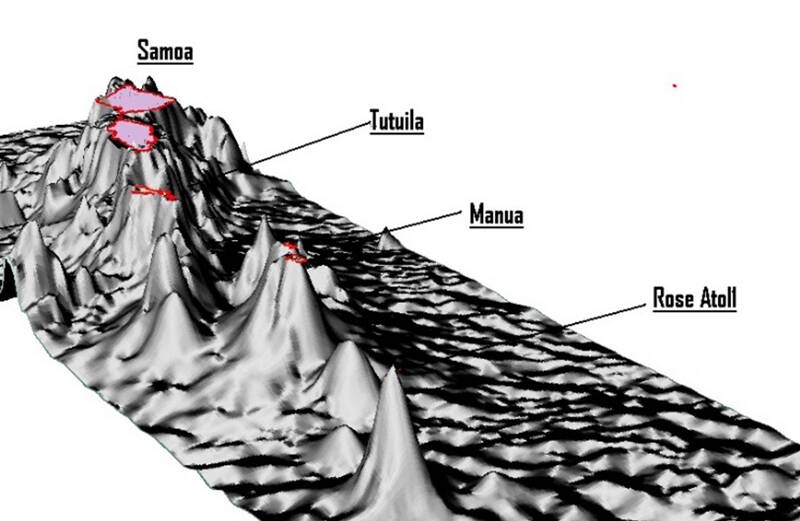
By Atuatasi Lelei Peau, Deputy Superintendent - National Marine Sanctuary of American Samoa

Bathymetric image showing the underwater chain of islands and seamounts in the Samoan archipelago. The Samoan archipelago is made of several main inhabited islands (Upolu, Savai’i, Tutuila, and the Manu’a islands), with other smaller islands such as Swains and Rose Atoll in American Samoa and Monono and Apolima in Samoa. The archipelago is divided politically, but is ecologically, culturally, and geologically connected. Image courtesy of Paul Anderson from SPREP. Download larger version (jpg, 235 KB).
Migrants from Southeast Asia arrived in the Samoan islands more than 2,000 year ago and from there settled the rest of Polynesia further to the east. Contact with Europeans began in the early 1700s but did not intensify until the arrival of English missionaries and traders in the 1830s.
At the turn of the 20th century, the Samoan islands were split into two sections. The eastern islands became territories of the United States in 1904; today they are known as American Samoa. The western islands became known as Western Samoa (now the Independent State of Samoa), passing from German control to New Zealand in 1914. New Zealand administered Western Samoa under the auspices of the League of Nations and then as a United Nations trusteeship until independence in 1962. Western Samoa was the first Pacific Island country to gain its independence.
Despite modern influences, Samoan people still hold firmly to "Fa'a Samoa," the traditional Samoan way, related to their language, dress, food, customs, and even property.
Fa'a-Samoa (the Samoan way) is a living tradition and continues to define the Samoan way of life. It is the foundation of Polynesia's oldest culture - dating back some 3,000 years. Fa'a-Samoa is interconnected with Samoan lands and waters. By sharing the intact and vibrant traditions, values, and legends that connect the Samoan people to the land and sea, the local community plays an integral role in the protection and preservation of natural and cultural resources of the area.
Fa'a-Samoa places great importance on the dignity and achievements of the group rather than on individual achievements. The traditional communal lifestyle revolves around the aiga, or family. Aiga are headed by leading matai (chief) or Sa'o, who manage the communal economy, protect and distribute family lands, are responsible for the welfare of all in their aiga, and represent the family in councils.
Despite outside influences and their status as U.S. nationals, American Samoans hold on to ancient traditions more tightly than many other Pacific Islanders. One key factor in the integrity of Samoan culture is the endurance of the Samoan language. As of the 2000 census, about 90 percent of the population in American Samoa speak Samoan at home. Respecting Fa'a-Samoa is paramount in the work done by the sanctuary, monument, refuge, and park, and we place a high value on partnerships with Samoan communities.
American Samoa is a small archipelago in the South Pacific Ocean and is comprised of five volcanic islands (Tutuila, Ta'u, Ofu, Olosega, Aunu'u) and two coral atolls (Swain's and Rose Islands). It is the United States' only territory south of the equator, situated about 4,000 kilometers (2,600 miles) south west of Hawaii, east of the island of Samoa (Western Samoa) and 1,200 kilometers south of the island of Kiribati.
Spoken languages are Samoan (89 percent; closely related to Hawaiian and other Polynesian languages), English (4 percent), and Tongan.
With an area of 199 square kilometers, American Samoa is slightly larger than Washington, DC. The U.S. territory has a population of 54,300. The capital town is Pago Pago on the island of Tutuila. Tutuila contains about two thirds of the total area and is home to 95 percent of the 64,000 islanders.
The Independent State of Samoa, known as Western Samoa until 1997, is made up of nine volcanic islands, two of which - Savai'i and Upolu - make up more than 99 percent of the land. It was governed by New Zealand until its people voted for independence in 1961. It has the world's second-largest Polynesian group, after the Maori.
Samoa's deeply conservative and devoutly Christian society centers around the extended family, which is headed by an elected chief who directs the family's social, economic, and political affairs, and the church, which is a focus of recreational and social life.
The economy revolves around fishing and agriculture, which is vulnerable to cyclones and disease. Attempts at diversification have met with success. Tourism is growing, thanks to the islands' scenic attractions and fine beaches. Offshore banking spearheads an expanding services sector. Light manufacturing is expanding and has attracted foreign investment.
In regional and international forums, the United States and Samoa work together to protect the environment and fisheries, promote sustainable economic development in the Pacific region, and strengthen the tenets of democracy and human rights. Through its embassy, the United States also engages with the Samoan Government on bilateral and multilateral issues including regional security and international law enforcement.
Jacob, L; Buchhianeri, K; Carruthers, T; Green, A; Leberer, T; Ropeti, M; Salaun, P and F Sauafea-Leau. (2013). Two Samaos Reef Resilienc Workshop For Marine Managed Area Practitioners Workshop Report.
U.S. State Department and Central Intelligence Agency websites.